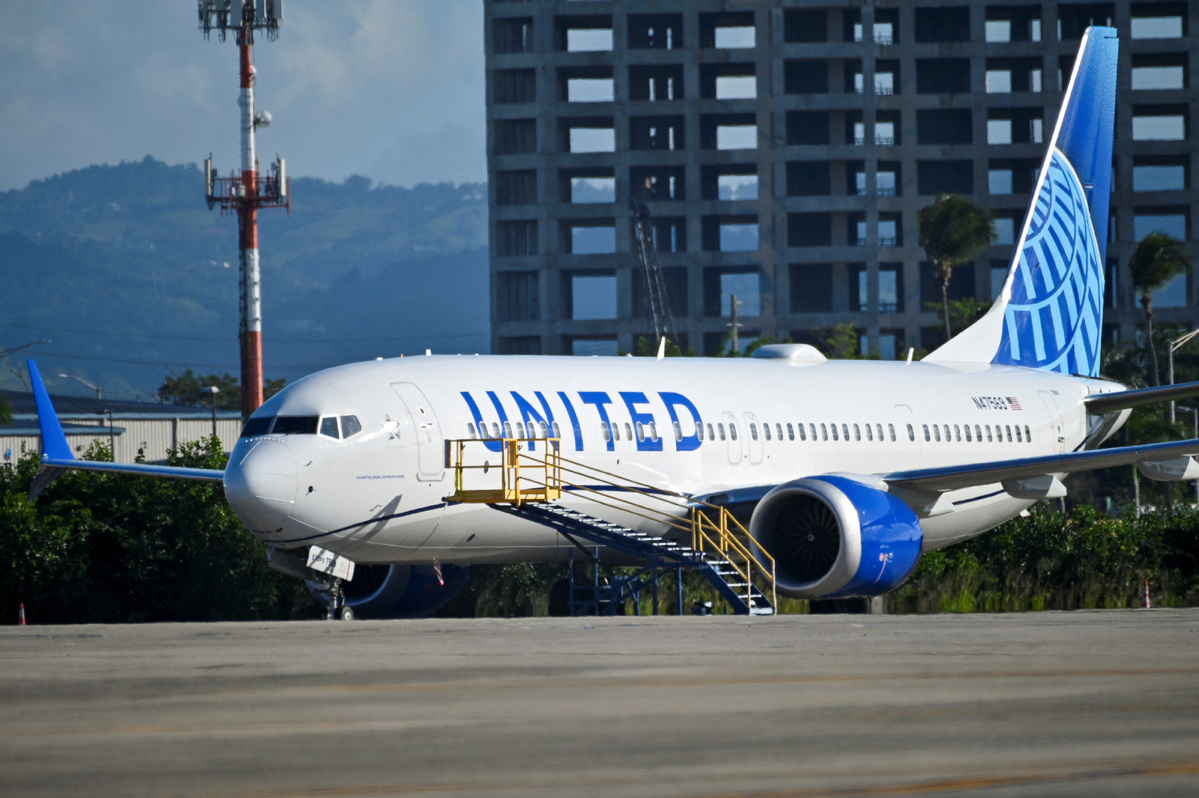US airlines' handling of China route criticized


US airlines could be suppressing competition in the direct-flight market between the United States and China because they may be unable to compete for numerous reasons, including shortages of wide-body planes, pilots and maintenance crews.
That could be why the airlines are seeking to limit the number of flights, while they state other reasons, observers said.
Major US airlines urged the federal government last week to pause approving more direct flights between the US and China because they claim that unlike China, they can't fly a shorter route over Russia.
They say Chinese airlines have an advantage by continuing to access Russian airspace, while US carriers stopped flying through Russian airspace at the start of Russia's conflict with Ukraine in February 2022.
The letter, signed by the Air Line Pilots Association, Allied Pilots Association and Association of Flight Attendants, also called for limiting US-China flights "until US workers and businesses are guaranteed equality of access in the marketplace, free from the existing harmful anti-competitive policies of the Chinese government".
"That sounds like price-fixing by not allowing competition," Matthew Schwartz, a computer engineer in Houston who has recently flown to South Korea, told China Daily. "The US airlines only care about protecting their profits, not the interest of air travelers. Any time competition is limited, consumers suffer."
Schwartz said that US carriers' inability to fly a shorter route isn't China's fault.
"The US imposed sanctions on Russia by barring Russian carriers flying over US airspace in 2022. Russia did reciprocally," Schwartz said. "It's a self-made problem by US policy. We shouldn't be penalizing China for that."
However, US airlines' objection of more flights over China's advantage of flying Russian airspace isn't entirely valid. FlightAware records show Chinese flights recently approved by the US aren't flying over Russia, and only 12 Chinese flights to the US that never stopped operating during the pandemic are still using Russian airspace.
In February, the US Transportation Department (DOT) increased weekly round-trip flights between China and US to 50, effective March 31, up from the previous 35. That means that both US and Chinese airlines are each authorized to fly 50 direct flights a week.
US carriers, however, aren't using all those flights. According to a March report by FlightGlobal, American Airlines, Delta Airlines and United Airlines in February requested and received authority from the DOT to delay resuming weekly flights to China by an additional waiver for 90 days through October. The DOT can rescind those approvals if carriers fail to operate the flights.
Unable to operate all currently activated flights to China, the US carriers are concerned that the federal government might increase the flights to as many as 100 a week. Prior to the pandemic, each country was allowed to fly more than 150 flights a week.
In requesting the additional waiver, American Airlines told the DOT that "the majority of pre-pandemic frequencies remain un-operated and likely will remain so through at least the 2024 summer season, since US-China passenger demand hasn't recovered to pre-pandemic levels".
But that statement was contrary to the DOT's reason for increasing the flights. The agency said it had made the decision after assessing market conditions and considering public interest.
Many travelers disputed the US carriers' claims, and Schwartz's view was echoed by the overwhelming majority in more than 1,800 comments on Yahoo Finance regarding their request. They accused the airlines of caring only about profits and making consumers pay more.
"These excuses the airlines are using to prevent more flights only have one outcome: higher ticket prices for the consumer,'' a reader by the name of Joshia wrote on Yahoo. "The only result of fewer flights is higher ticket prices."
Another commenter, William, said that he regularly flew United Airlines to Shanghai in business class for $6,500 before the pandemic.
"Last month I checked prices and it was $54,000 for a fully refundable ticket, $12,400 for non-refundable. Of course they don't want to approve more flights; they're able to hammer us on prices right now," he wrote.
The suppressed competition imposed on Chinese airlines by the US also drives up airfares between the US and other major Asian cities, other travelers said.
"I fly to Asia every six weeks, what used to cost business class pre-COVID is now almost double, $3,600 vs $6,500 is what I paid two weeks ago," Shawn wrote. "It's definitely punishing my business travel."
Many readers said that the US airlines' request was precisely the example of anti-competition on which many readers commented.
"This is yet another sign that the American airline industry cannot compete with Chinese airlines in price and quality of service. This is yet another form of protectionism," reader Imurdad said of the airlines' request.
"Keep in mind that US law is also seen as predatory in the aviation industry. When a US carrier declares Chapter 11 reorganization, it's released from debts such as landing, airport fees, navigation fees," reader Michael wrote, adding that most major airlines including Delta, United and American declared Chapter 11 bankruptcy and avoided paying billions.
The readers are saying that the US airlines lack competitive ability because they are currently facing shortages of wide-body planes, traffic controllers, pilots and maintenance technicians.
Industry insiders said that currently the US carriers don't have enough wide-body planes to operate more extra flights between the US and China. The shortage is due to the US carriers having fewer planes now than in the pre-pandemic era, and they prioritized direct flights to European destinations because those are shorter and more profitable.
According to a 2023 study by consulting firm Oliver Wyman, post-pandemic air travel demand has outpaced the supply of pilots, and the industry is currently short 11 percent, equivalent to roughly 8,000 pilots.
The shortage was due to multiple factors: a wave of early retirements during the pandemic; a shrinking pool of potential pilots from the military; and mandatory retirement age of 65 for pilots that is already older than the general workforce. According to a study by the US Government Accountability Office, about 40 percent of active airline pilots were between the ages of 50 and 64 in 2022.
The pilot shortage is projected to get worse in the near future, with the aging workforce. Oliver Wyman's latest figures project the gap between pilot supply and demand in 2032 to reach around 13,300 in the US.
The US is also facing a shortage of aviation maintenance workers, Wyman said. The aviation industry is short 24,000 maintenance technicians in North America, which will increase to nearly 40,000 by 2028.
Additionally, the US faces a shortage of ground air traffic controllers. The Federal Aviation Administration estimated in November 2023 that it has 1,000 fewer certified controllers than a decade ago. The agency has resorted to halting departures to ensure safety.
Travelers have felt the shortage. Reader Frederic wrote that the last time he traveled, United Airlines "ruined part of my hard-earned vacation" because of "flight delay due to lack of available crew to swap aircraft".
"American Airlines is always delayed and I had to pay the price of stress every time I flew with them." Another reader complained of a canceled flight due to no pilot.
Their experiences matched the broader picture. A report by the US Public Interest Research Group showed that more than 26,000 formal complaints were filed against US airlines in the first five months of 2023, an increase of 109 percent over the same period in 2022. Last December, the complaints were so numerous that the DOT had to delay the data release.

































